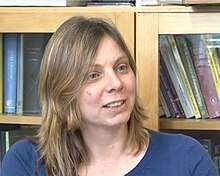Sara Russell
Sara Samantha Russell (born 1966) is a professor of planetary sciences and leader of the Planetary Materials Group at the Natural History Museum, London. She is a Fellow of the Meteoritical Society and of the Royal Astronomical Society.
Sara Russell | |
|---|---|
 Russell speaks on The Moon Landings & Cosmic Mineralogy in 2012 | |
| Born | 1966 (age 53–54) |
| Alma mater | |
| Scientific career | |
| Institutions |
|
Early life and education
Russell was captivated by the Moon landing as a child.[1][2] She studied at the University of Cambridge, where she was introduced to microanalysis by Jim Long.[3] She had started studying natural sciences, but heard that geologists host the best parties, so switched courses.[3] She was inspired to complete a PhD degree in geology after attending a lecture by Colin Pillinger, and moved to the Open University.[3][4] She won the Royal Astronomical Society Keith Runcorn Prize for the best British doctoral thesis in geophysics in 1993.
Career
Russell completed postdoctoral research at the California Institute of Technology and Smithsonian Institution.[5][6][7] She joined the Natural History Museum in 1998, where she studied protostars and planets.[8] In 2000 she edited the collection Protostars and Planets IV.[9] Russell is leader of the micrometeorite and meteorite collection at the Natural History Museum, London.[10] She has been on three expeditions to Antarctica searching for meteorites.[1][11] She has been awarded the Antarctica Service Medal.[12] She was awarded a Leverhulme Trust grant in 2005.[13] In 2006 she studied the meteorites in the early solar system and the protoplanetary disc.[14]
On behalf of the Natural History Museum, Russell was part of the team which arranged the acquisition of the Ivuna meteorite in 2008.[15][16] In 2009 she published the book Meteorite with Caroline Smith and Gretchen Benedix.[17] She won the Geological Society of London Bigsby Medal in 2010.[18][19] In 2011 Russell took part in an exhibition at the Royal Observatory, Greenwich.[20] She is a science team member of OSIRIS-REx.[11] She was the initial point of contact in the process by which the Tissint meteorite came to be acquired by the Natural History Museum in 2012.[21] In 2014 she studied moon rocks brought back by the Apollo Astronauts, finding that the lunar crust did not form from a common source.[22][23]
Russell has studied the origin of water in the inner solar system with Monica Grady.[24] She published Chondrules in 2018, a book which considers the silicate grains that form in the protoplanetary disk.[25] The eponymous asteroid 5497 Sararussell was named after her. Russell is an advocate for diversity in science.[26]
References
- The Natural History Museum (2007-07-20), Sara Russell on travelling to Antarctica | Natural History Museum, retrieved 2018-08-10
- "Museum Lives Staging | Natural History Museum". www.nhm.ac.uk. Retrieved 2018-08-10.
- "The Geological Society of London - 2010 Awards: Citations, Replies". www.geolsoc.org.uk. Retrieved 2018-08-11.
- "1998 Mineralogical Society-Schlumberger Medal" (PDF). Mineralogical Society. 1999-01-07. Retrieved 2018-08-10.
- Cassidy, William A. (2012-03-29). Meteorites, Ice, and Antarctica: A Personal Account. Cambridge University Press. ISBN 9781139437035.
- McCall, Gerald Joseph Home; Bowden, A. J.; Howarth, Richard John (2006). The History of Meteoritics and Key Meteorite Collections: Fireballs, Falls and Finds. Geological Society of London. ISBN 9781862391949.
- "Meteorite studies". www.nsf.gov. Retrieved 2018-08-10.
- Russell, Sara S.; Boss, Alan P. (1998-08-14). "Protostars and Planets". Science. 281 (5379): 932–933. Bibcode:1998Sci...281..932R. doi:10.1126/science.281.5379.932. ISSN 0036-8075.
- "The University of Arizona Press : Protostars and Planets IV". 2017-06-16. Archived from the original on 2017-06-16. Retrieved 2018-08-11.
- Russell, Sara; Grady, Monica M. (2006-01-01). "A history of the meteorite collection at the Natural History Museum, London". Geological Society, London, Special Publications. 256 (1): 153–162. Bibcode:2006GSLSP.256..153R. doi:10.1144/GSL.SP.2006.256.01.08. ISSN 0305-8719.
- "Royal Astronomical Society". www.ras.org.uk. Retrieved 2018-08-10.
- Russell, Sara S.; Jr, Harold C. Connolly; Krot, Alexander N. (2018-06-30). Chondrules: Records of Protoplanetary Disk Processes. Cambridge University Press. ISBN 9781108304672.
- "The Leverhulme Trust 2005". The Leverhulme Trust. 2005. Retrieved 2018-08-11.
- Lauretta, Dante S.; McSween, Harry Y. (2006). Meteorites and the Early Solar System II. University of Arizona Press. ISBN 9780816525621.
- Sample, Ian (2015-09-22). "Meteorite from birth of solar system to go on display". the Guardian. Retrieved 2018-08-10.
- "The Geological Society of London - NHM buys new meteorite". www.geolsoc.org.uk. Retrieved 2018-08-10.
- results, search; Russell, Sara; Benedix, Gretchen (2009-09-03). Meteorites (Revised ed.). London: The Natural History Museum. ISBN 9780565092399. ASIN 0565092391.
- "The Geological Society of London - Bigsby Medal". www.geolsoc.org.uk. Retrieved 2018-08-10.
- "Society Awards for 2010". Journal of the Geological Society. 167 (5): 841–842. 2010-08-23. Bibcode:2010JGSoc.167..841.. doi:10.1144/0016-76492010-Awa. ISSN 0016-7649.
- Murdin, P (2001), "Royal Observatory, Greenwich", The Encyclopedia of Astronomy and Astrophysics, IOP Publishing Ltd, p. 4203, Bibcode:2000eaa..bookE4203., doi:10.1888/0333750888/4203, ISBN 978-0333750889
- Chang, Kenneth. "Meteorite From Mars Is at Home in London, After a World Tour". Retrieved 2018-08-10.
- "Meteorites expose Moon surface formation". Retrieved 2018-08-10.
- Russell, Sara S.; Joy, Katherine H.; Jeffries, Teresa E.; Consolmagno, Guy J.; Kearsley, Anton (2014-09-13). "Heterogeneity in lunar anorthosite meteorites: implications for the lunar magma ocean model". Phil. Trans. R. Soc. A. 372 (2024): 20130241. Bibcode:2014RSPTA.37230241R. doi:10.1098/rsta.2013.0241. ISSN 1364-503X. PMC 4128264. PMID 25114312.
- Russell, Sara S.; Ballentine, Chris J.; Grady, Monica M. (2017-05-28). "The origin, history and role of water in the evolution of the inner Solar System". Philosophical Transactions of the Royal Society A: Mathematical, Physical and Engineering Sciences. 375 (2094): 20170108. Bibcode:2017RSPTA.37570108R. doi:10.1098/rsta.2017.0108. ISSN 1364-503X. PMC 5394259. PMID 28416731.
- Russell, Sara S.; Jr, Harold C. Connolly; Krot, Alexander N. (2018-07-19). Chondrules: Records of Protoplanetary Disk Processes. Cambridge University Press. ISBN 9781108418010.
- "NASA experts and maggot races in Science Uncovered at the Natural History Museum | Culture24". www.culture24.org.uk. Retrieved 2018-08-10.